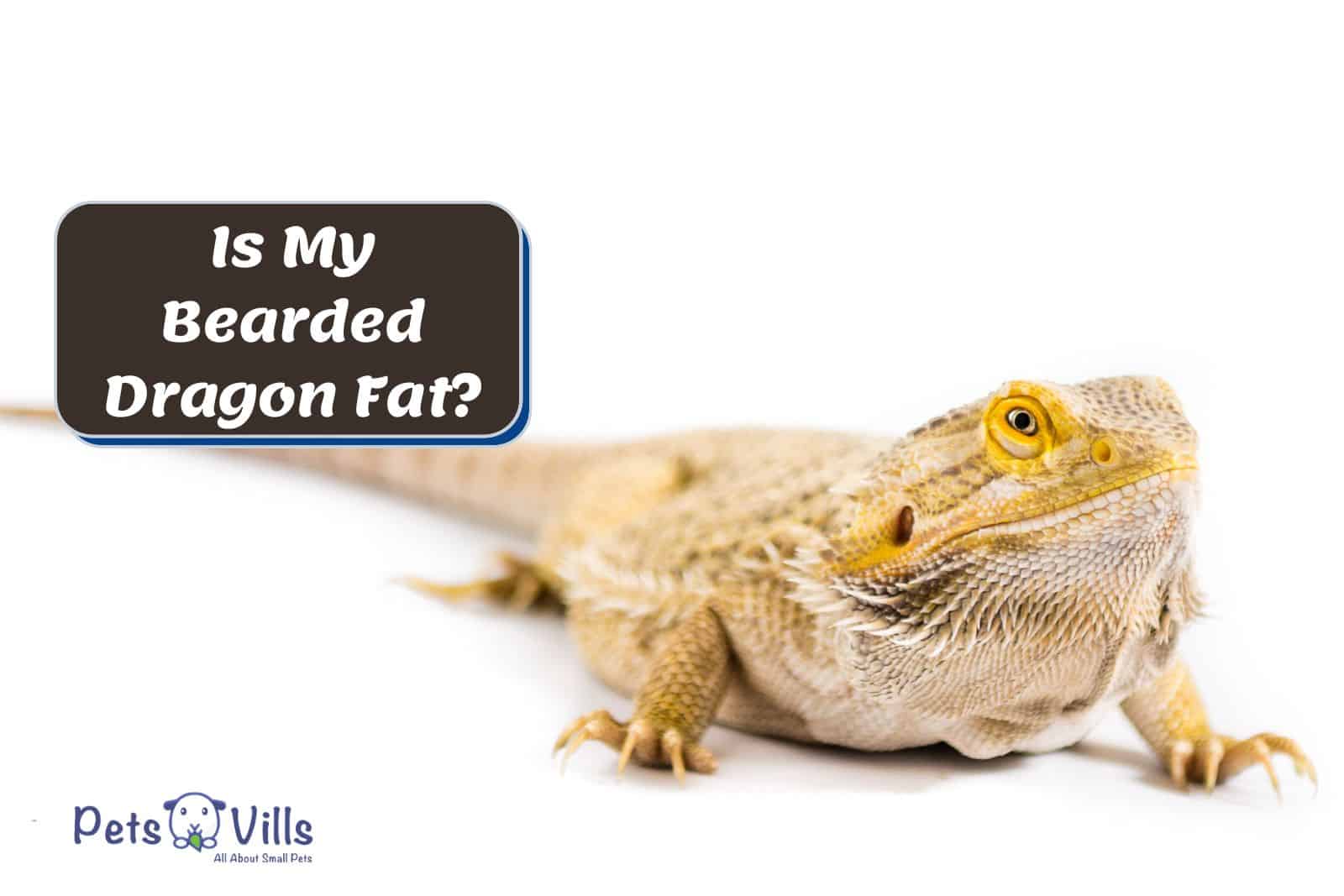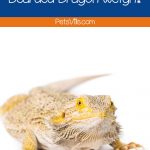What does a fat bearded dragon look like?
Some owners love fat dragons, but that’s a dangerous road you are best to avoid.
I found that out the hard way when my overweight dragon started having health issues.
Here I will discuss how to recognize your dragon is fat and what you can do about it.
This post contains affiliate links. We earn a commission if you make a purchase after clicking on our links.
Don’t have time? Check this comparison table of our top faves!
Table of Contents
How Much Should a Bearded Dragon Weigh?
You might wonder if there is a healthy weight for a dragon? How much should a beardie weigh anyway?
An average adult bearded dragon should weigh between 280 and 510 grams. (1) This weight varies depending on the age of the dragon or its gender.
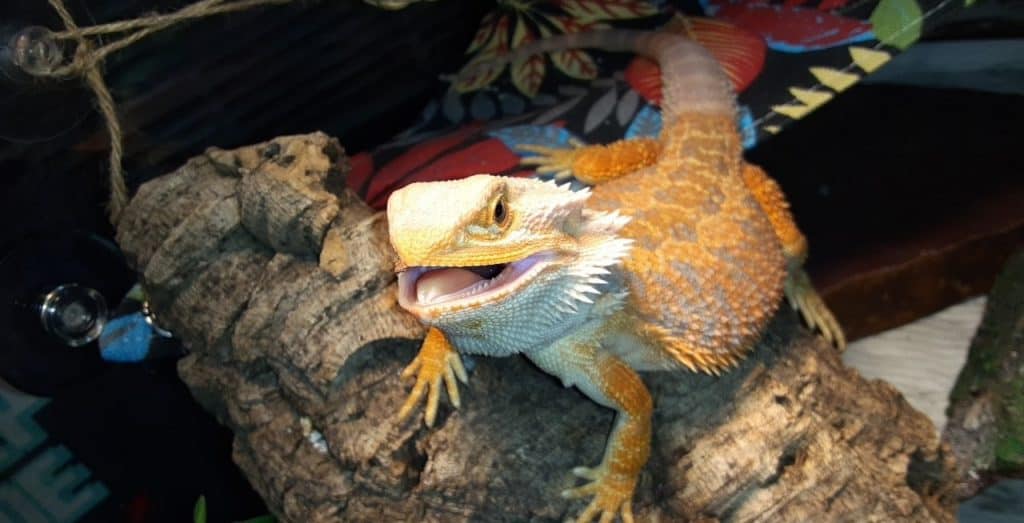
Check this bearded dragon size chart to know the ideal weight of beardies as they age. I have added the length for more straightforward comparison with weight and age.
| Size | Weight (Grams) | Age |
| 3 to 4 inches | 4 to 6 | One month and below |
| 5 to 9 inches | 8 to 40 | 1 to 2 months |
| 8 to 11 inches | 22 to 110 | 2 to 3 months |
| 9 to 12 inches | 41 to 115 | 3 to 4 months |
| 11 to 16 inches | 102 to 115 | 4 to 5 months |
| 11 to 18 inches | 183 to 188 | 5 to 6 months |
| 13 to 18 inches | 230 to 288 | 6 to 7 months |
| 14 to 20 inches | 252 to 327 | 7 to 8 months |
| 16 to 22 inches | 280 to 360 | 8 to 9 months |
| 16 to 24 inches | 350 to 465 | 9 to 10 months |
| 16 to 24 inches | 380 to 465 | 10 to 11 months |
| 16 to 24 inches | 380 to 500 | 11 to 12 months |
| 16 to 24 inches | 380 to 500 | 12 to 18 months |
| 16 to 24 inches | 380 to 500 | 18 to 24 months |
A healthy bearded dragon should be as close as possible to the numbers in the chart. Obese bearded dragons can weigh as much as 900 grams!
Is My Bearded Dragon Fat, Overweight or Obese? [How Do I Know]?
Beardies can be fat but not overweight and overweight but also not obese. I know that threw you off a little. Sometimes, there’s no need to worry when you see a plump dragon.
How do you tell the difference, though?
Weigh the Dragon
The surest way to see if the excess weight on your dragon amounts to obesity or being overweight is to weigh it.
A simple weighing scale will let you know the weight of the dragon. You can compare the dragon’s weight with the corresponding age and size on the chart above.
If your beardie shows excess weight, the scale will expose that. A healthy lizard can weigh from 250 to 700 grams.
Fat dragons will typically hover around 800 grams. Anything above 900 grams is a sign of obesity, and you should be alarmed.
Prominent Fat Pads
Bearded dragon fat pads are the first features that you might notice that indicate a fat dragon. Fat pads are the fat pockets beardies use to store excess fat in times of plenty.
In an obese or overweight dragon, the pads are pretty prominent. You won’t struggle to see them on the beardie’s head, tail, abdomen, and forearms. Some can even be as large as the beardie’s eyeballs!
This video gives you a visual example of a fat beardie.
In the video, the beardie has a lot of fat stored all over its body, and even the tail seems fat. The larger these fat pads, the fatter the beardie is. You will also quickly feel these fat pockets if the beardie is fat.
Fat VS Overweight VS Obese Bearded Dragon: Know the Difference!
As you already know, a beardie can be fat without being classified as overweight or obese. Therefore, you can’t use the terms fat, overweight, and obese interchangeably.
Here is why:
Plump bearded dragons have some fat on their bodies, but not too much. They don’t struggle to move like Large Marge in this video.
Still, keep a close eye on them to avoid slipping into the overweight category. (More on that later)
When someone is overweight, they weigh more than you would expect them to weigh at their age or height. (2) Therefore, when an adult bearded dragon is chubby, it weighs significantly more than you would expect them to at its age, size, and gender.
A typical adult bearded dragon should weigh 380- 500 grams according to the weight chart. So, if a dragon weighs 700-850 grams, we can classify it as overweight.
An obese dragon will often have weight numbers that are off the charts. It could be 900 grams or more. Even 800 grams should be considered obese and dangerous for adult beardies depending on its length.
Signs Your Beardie Dragon Has a Weight Problem
I’ve seen dragon owners with a weakness for plump bearded dragons. However, most of them didn’t know how to tell when the weight gain had become too much.
Dr. Thomas H Boyer of the Pet Hospital of Penasquitos says beardies are prone to obesity due to overfeeding. (3) But how do you know your beardie is gaining way too much weight?
While signs of a healthy bearded dragon can be easy to spot, few people can tell when a beardie is obese.
So here are the signs to look out for.
Visible Abdominal Fat
Visible abdominal fat is a clear sign of obesity on your pet. An overweight bearded dragon’s fat belly will often distend and scrape on the ground as the beardie moves. A healthy beardie usually has a relatively trim belly.
Look at this example of a beardie that has a distended belly. You can easily tell that she is fat.
Visible Fat Pads
In an obese bearded dragon, the fat pads are usually quite large. The easiest to spot are those on the head. You can quickly feel them and see them with little effort.
This video explains that overweight beardies have fat pads behind their forelegs. That’s something you would never see in a healthy dragon.
These pockets of fat, while integral to the survival of the beardie, can also make them obese.
You will also see these pockets of fat all over the beardie’s body. That should be a clear sign your reptile is fat.
Difficulty Moving
Remember Large Marge?
See how her belly was too fat it scraped on the floor? She also easily got stuck. Movement becomes a massive problem for obese dragons because they carry too much weight in their bellies and body parts.
Because of this difficulty moving the dragon will typically appear sluggish.
Thick Tail Base
An obese bearded dragon stores fat in the tail base as well. You’ll see the tail appear large when it should only be small.
Jowl Fat
While not advisable for a dragon’s chin to be sunken, it also shouldn’t be too fat. Fat bearded dragons usually appear to have a double chin. When the fat is too much, it will also get deposited on the chin.
That is also a clear sign of excess body weight.
Weight Problem in a Beardie or Something Else: How to Differentiate
Sometimes signs of excess weight in a dragon don’t mean the dragon is overweight. Thomas Mazorlig, author of Animal Planet: Bearded Dragons, says telling if a dragon is fat is challenging. (4)
That’s because some conditions make the dragon seem overweight when it’s not.
Pregnancy
Dr. Jess says gravid females can quickly gain weight and have a large body size. (5) So, you might think your female pet dragon is fat when they are only ‘pregnant.’
The female beardie will have an enormous belly, seem sluggish, and move less when that happens. That happens despite no apparent change in diet.
READ MORE: How long are bearded dragons pregnant for?
Constipation
Constipation is common for most beardies. (6) And when that happens, they’ll look like they have put on a ton of weight. Their bellies will be large because of the overload of feces within their body.
If you have been consistently feeding them the same diet, visit a vet for confirmation.
Large Belly After Eating
Beardies can eat till they become bloated and have large bellies that scrape on the floor as they move. Though large bellies are signs of obesity, it’s normal for the bellies to be large after a meal.
After some time, the dragon’s belly should return to standard size. So don’t confuse that for a weight problem.
What About a Bearded Dragon’s Fat Neck: Is It Normal?
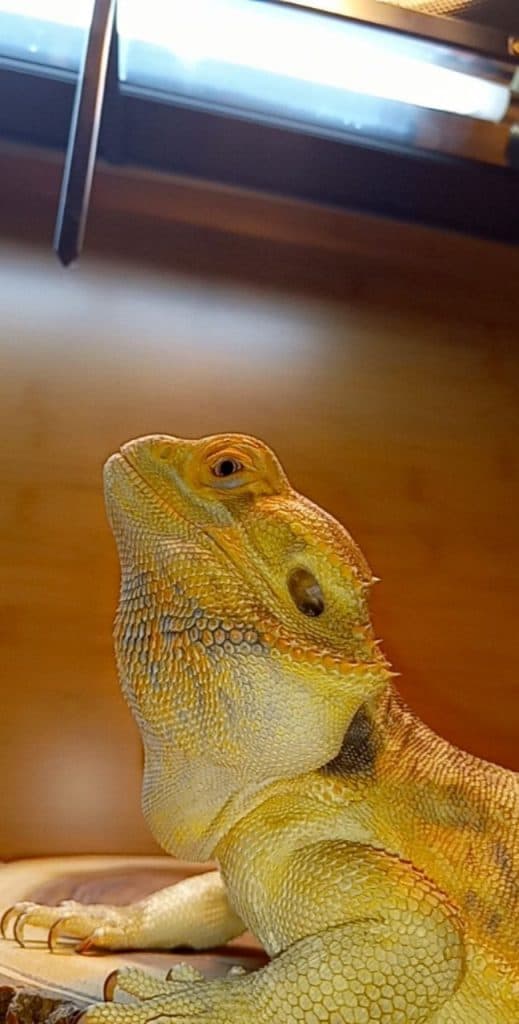
A fat neck in a beardie can be normal or something you have to worry about. A normal time to see this is when the beardie wants to ward off an aggressor as a defense mechanism.
The dragon puffs out its neck to appear larger and more intimidating. (7)
But what if there isn’t an aggressor, and the neck still appears fat? Then your beardie is fat. I mentioned earlier that beardies have fat pads for survival. The pads can also be on the beardies neck to store excess fat.
So, if you see your beardie has a fat neck that isn’t going away, it could be a sign that they are overweight. Depending on the size of the neck, you can tell whether it’s an issue that needs immediate veterinary attention or not.
Why Is My Bearded Dragon Fat/ Obese?
In their first months of life, beardies have large appetites, which is what you want. All you want is for them to grow fast and achieve healthy body weight.
However, even then, you are always just a few feedings from obesity. So what causes obesity?
An Improper Diet
To borrow the cliche, you are what you eat. This also applies to dragons. And that’s why the first place to look when you have an obese dragon is the diet.
Beardies are omnivores since they survive on a diet of insects and greens. When it is actively growing, a juvenile dragon needs a high protein diet. (8)
However, this high protein diet will lead to weight gain. Greens serve as a countermeasure to the fattening effect of the proteins. (9)
Overfeeding
Can you overfeed a bearded dragon? Dr. Thomas H Boyer says it’s easy to overfeed your dragon. Most new bearded dragon owners don’t understand the proper feeding frequency for their pets.
So they overfeed their dragons and end up making them fat.
Lack of Brumation
Brumation is the state of hibernation wild dragons do to survive times of food scarcity. (10) But in captivity, few dragons brumate.
So they don’t get to use up the stored fats. Coupled with constant feeding, you find yourself with a lazy bearded dragon that’s also overweight.
Lack of Exercise
Veterinary doctor Scott J. Stahl says beardies are active animals that need large enclosures. (11) But in captivity, many owners rarely make their beardies exercise.
Picture an overfed dragon, on a fatty diet, doesn’t brumate, and has abysmally low physical activity levels. How fat would that dragon be? Your guess is as good as mine.
How Does a Weight Problem Affect Your Beardie’s Health?
A weight problem could be disastrous for your beardie. You only need to look up most bearded dragons info on the web and see they all stress the importance of a proper diet.
A prolonged weight issue for your beardie could lead to any of the below health complications.
- Hepatic Lipidosis or fatty liver disease happens when a beardie’s coelomic fat pads continue holding fat because of a slow use rate. (12) Overaccumulation of fat in the liver causes this disease. It is a serious disease and could kill the dragon. (13)
- Dystocia is a health complication where female lizards fail or struggle to lay eggs despite being sexually mature and mating. (14) Obesity can lead to the disease because fat distorts a female dragon’s body, leading to difficulty laying.
- Constant gasping for breath: A fat beardie struggles to carry its weight around. It can become common to hear your beardie gasping for breath as it struggles to move.
- Excess Pressure on Bones: There is a specific number of grams a beardie should weigh so that it can support its body. The legs could struggle to support the massive bulk if it becomes too fat. That will cause the leg bones to crush from the pressure.
How to Help Bearded Dragon Lose Weight?
After establishing a beardie is fat, you’ll need to help it lose its weight gradually. Here is what you can do to help it.
1. Get The Beardie on a Proper Diet
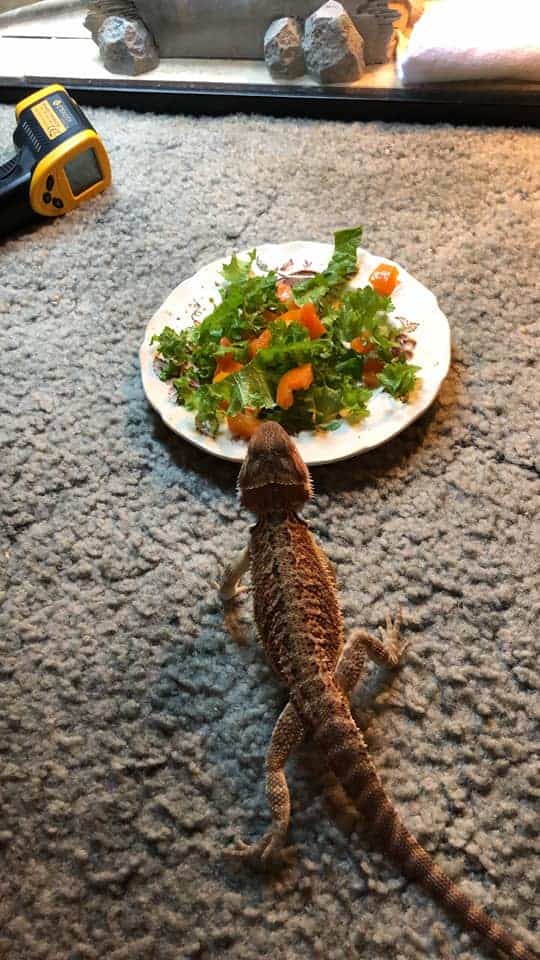
Diet is the most notorious cause of obesity in beardies. Therefore, fixing it will help you reduce the animal’s weight.
Improving the diet means gradually switching from feeder insects to a diet full of leafy greens and other vegetation.
You can start early enough by encouraging baby beardies to eat green vegetables though juveniles enjoy live feed more. Gradually increase the ratio of vegetables as the beardies grow.
Adult beardies are easier to get off a high protein diet and onto a diet with more nutritious food. Green vegetables will help keep their weight in check.
Dr. Boyer also says to eliminate fruits from the beardies diet. Fruits should only be used as occasional treats.
2. Reduce the Feeding Frequency
We bearded dragon owners are often guilty of overfeeding our pet reptiles. So, getting the feeding frequency right will ensure they eat less food and lose weight.
Adult dragons can do well by eating only once or every other day. (9) The change shouldn’t be drastic but gradual. If you have been feeding your beardie at different intervals, start by gradually cutting down meal frequency.
3. Induce Brumation
During brumation, beardies don’t eat, which gives them a chance to use up fat stores. So, inducing brumation will help them cut their weight.
You can induce brumation by manipulating the dragon’s body temperature. A slight drop in the temperatures might set off some beardies. (15) However, it isn’t advisable to induce brumation in a beardie less than one-year-old.
A young beardie still has a lot of development and might not have enough reserves to last the entire brumation period.
4. Encourage Exercise
You can increase the amount of exercise a beardie does by adding more climbing structures to their enclosure. You can also use a bearded dragon leash and take them out for a walk.
Alternatively, you could also let them roam the garden if you have a suitable one. Another way is to make them run to get their live food. That mimics their natural environment and ensures they’re active.
When Should You Contact the Vet For a Weight Problem in a Bearded Dragon?
As soon as you notice weight gain, you should contact a vet. A certified exotic pet vet will help you decide on the best way to help the dragon lose weight.
They can also help determine if it’s merely pregnancy in a female lizard, some other reason, or if it genuinely gains weight.
FAQs
Where do beardies store fat?
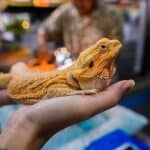
Beardies store fat in fat pads on their head, tail base, and belly.
What should I feed my bearded dragon?
Juvenile dragons should eat a diet of 80% live feed and 20% greens. Adult dragons can survive on less live food since they are usually more herbivores than omnivores.
Conclusion
Are you concerned you could be raising a fat bearded dragon? Hopefully, the tips I have shared here will help you better manage your dragon’s weight.
You might love plump dragons, but that isn’t always the best path. A dragon’s weight, like humans, needs to be carefully managed to avoid health complications.
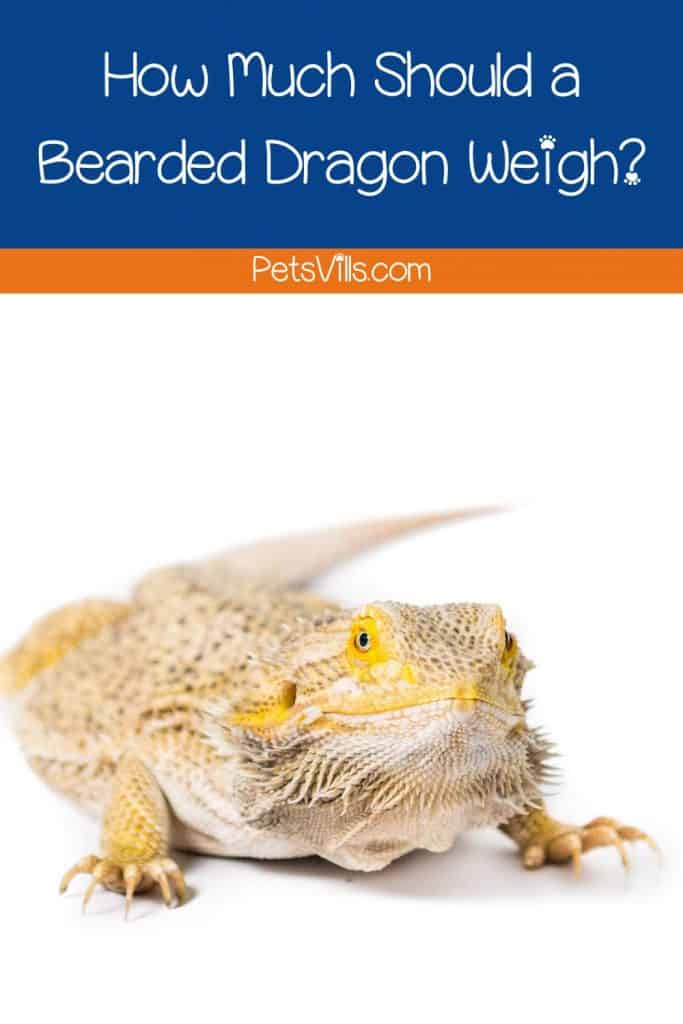
What do you think of this topic? Let us know below!
Resources
- 1. Schabacker S. Bearded Dragons [Internet]. National Geographic. 2019. Available from: https://www.nationalgeographic.com/animals/reptiles/facts/bearded-dragon
- 2. Overweight vs Obese – Difference and Comparison | Diffen [Internet]. Diffen.com. Diffen; 2019. Available from: https://www.diffen.com/difference/Obesity_vs_Overweight
- 3. Pet Hospital-Veterinary Specialist, Reptiles & Amphibians [Internet]. www.pethospitalpq.com. [cited 2022 Jun 5]. Available from: https://www.pethospitalpq.com/dr-boyer-veterinary-specialisthe-reptile-and-amphibian-vet.pml
- 4. Bearded Dragons (Animal Planet Pet Care Library) [Internet]. Amazon. [cited 2022 Jun 5]. Available from: https://www.amazon.com/Bearded-Dragons-Animal-Planet-Library/dp/0793837138
- 5. Jess AD. Bearded Dragons Eggs: What Do You Need To Know? [Internet]. Vet Explains Pets. 2020. Available from: https://vetexplainspets.com/bearded-dragons-eggs/
- 6. pbeakley. Constipation/Obstipation in Bearded Dragons [Internet]. azeah.com. 2013 [cited 2022 Jun 5]. Available from: https://azeah.com/lizards/constipationobstipation-bearded-dragons#:~:text=Constipation%2C%20which%20is%20the%20failure
- 7. petMD. 10 Bearded Dragon Facts You Should Know | petMD [Internet]. Petmd.com. 2017. Available from: https://www.petmd.com/reptile/care/10-things-you-didnt-know-about-bearded-dragons
- 8. Bearded Dragon Care Guide | Long Island Avian and Exotic Vet Clinic [Internet]. libirdexoticsvet. Available from: https://www.birdexoticsvet.com/bearded-dragon-vet
- 9. Bearded Dragons – Feeding [Internet]. vca_corporate. 2017. Available from: https://vcahospitals.com/know-your-pet/bearded-dragons-feeding
- 10. Bearded Dragon brumation [Internet]. Exoticdirect. Available from: https://www.exoticdirect.co.uk/news/bearded-dragon-brumation
- 11. Scott Stahl, DVM, ABVP-Avian [Internet]. Stahl Exotic Animal Veterinary Services. 2019 [cited 2022 Jun 5]. Available from: https://www.seavs.com/scott-stahl-dvm-abvp-avian-practice/
- 12. Boyer, DVM, TH. Diseases of Bearded Dragons [Internet]. [cited 2022 Jun 5]. Available from: https://newcms.eventkaddy.net/event_data/60/session_files/AV017_Conference_Note_jjacobs_cvma.net_AV017BOYERDiseasesofBeardedDragons_20150512213937.PDF
- 13. Paul Pion DVM, Spadafori G. Veterinary Partner. VINcom [Internet]. 2017; Available from: https://veterinarypartner.vin.com/default.aspx?pid=19239&catId=102919&id=8017925
- 14. bearded-dragons-problems | VCA Animal Hospital [Internet]. Vca. [cited 2022 Jun 5]. Available from: https://vcahospitals.com/know-your-pet/bearded-dragons-problems#:~:text=Dystocia
- 15. All About Brumation – Hibernating Pets | vet-n-pet Help [Internet]. vet-n-pet DIRECT Help Centre. [cited 2022 Jun 5]. Available from: https://help.vetnpetdirect.com.au/kb/all-about-brumation-hibernating-pets/
Alina Hartley is a small-town girl with a ginormous love of bearded dragons. It all started with Winchester, a baby bearded who was abandoned at the shelter by his former owners because of a birth defect that caused one front leg to be shorter than the other. Alina originally went to the shelter looking for a guinea pig, but one look at Winchester and it was love at first sight. From that day on, Alina has dedicated her life to learning everything she can about bearded dragons. She loves helping new beardie parents start their incredible journey with these magnificent reptiles.
Follow her on:
LINKEDIN
TWITTER.
Read her latest articles HERE
Learn more about her HERE.

